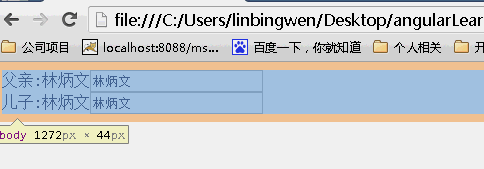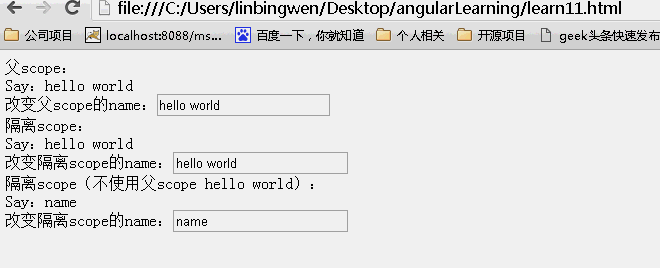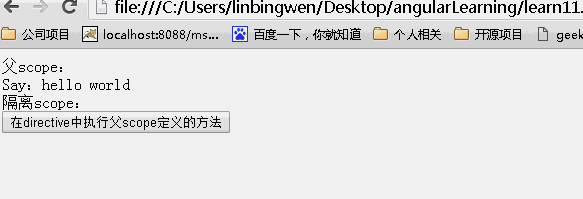directive 指令一
什么是Directive
Directive将一段html,js封装在一起,形成一个可以复用的独立个体,具有特定的功能。angularjs中的指令通常是比较小的组件,它相当于是给我们提供了一些公共的自定义的DOM元素、class属性或attr属性。除此之外,我们可以在这个基础上来操作scope,绑定事件,更改样式等等。通过Directive我们可以封装很多公共指令,比如分页、自动补全等多个指令,封装好后,我们下次复用只要在html页面上添加该指令就可以实现复杂的功能。
总结一下使用Directive的场景:
1.抽象一个自定义组件,在其他地方重用。
2.使html更具语义化,不需要深入研究代码和逻辑就可以知道页面实现了哪些功能。
angular封装了很多自己的指令,都是ng开头,比如ng-model,ng-controller,ng-show,ng-click等等,我们也可以封装自己的指令,在当前的节点上干点特别的事。
例子
html部分:
<body ng-app="testApp"> <div ng-controller="testController"> <input type="text" ng-model="city" placeholder="Enter a city" /> <my-test ng-model="city" ></my-test> <span my-test="exp" ng-model="city"></span> <span ng-model="city"></span> </div> </body>
js部分
var app = angular.module('testApp', [ 'directives', 'controllers' ]); // 自定义directive var myDirective = angular.modeule('directives', []); myDirective.directive('myTest', function() { return { restrict: 'EMAC', require: '^ngModel', scope: { ngModel: '=' }, template: '<div><h4>Weather for {{ngModel}}</h4</div>' }; }); // 定义controller var myControllers = angular.module('controllers', []); myControllers.controller('testController', [ '$scope', function($scope) { $scope.name = 'this is directive1'; } ]);
以上是一个自定义myTest这个directive的应用。来看一下定义一个directive可以用哪些格式和参数:
var myDirective = angular.module('directives', []); myDirective.directive('directiveName', function() { return { template: '<div></div>', replace: false, transclude: true, restrict: 'E', scope: {}, controller: function($scope, $element) { }, complie: function(tElement, tAttrs, transclude) { return { pre: function preLink(scope, iElement, iAttrs, controller) { }, post: function postLink(scope, iElement, iAttrs, controller) { } }; }, link: function(scope, iElement, iAttrs) { } }; });
我们可以发现directive最关键的部分就是通过return来设置参数,那么return里可以设置哪些参数呢,下面具体讲一讲这些参数及其说明。
1.name
当前scope的名称,一般声明时使用默认值,不用手动设置此属性。
2.priority
优先级。当有多个directive定义在同一个DOM元素上时,有时要明确他们的执行顺序。如果优先级相同,那么执行顺序不确定(一般情况下,优先级高的先执行,相同优先级的按照先绑定后执行)。
3.teminal
最后一组。如果设置为true,那么当前的priority将会成为最后一组执行的directive。也就是说,比这个directive的priority更低的directive将不会执行,同优先级的依然会执行,但执行顺序不确定。
4.scope
(1)true
表示为这个directive创建一个新的scope。如果在同一个元素中有多个directive需要新的scope的话,它还是只会创建一个scope。
(2){}
将会创建一个新的,独立的scope,这个scope与一般的scope的区别在于它不是通过原型继承父scope的。这对可复用的组件而言很有用,可以有效的防止读取或者修改父级scope的数据。
5.controller
controller允许其他directive通过指定名称的require进行共享,也就是说directive之间可以相互沟通,增强相互之间的行为。controller默认注入以下本地对象:
$scope:与当前元素结合的scope
$element:当前元素
$attrs:当前元素的属性对象
$transclude:一个预先绑定到当前scope的转置linking function
6.require
请求另外的controller,传入当前directive的linking function中,require需要传入一个directive controller的名称,如果没有对应的controller会抛出一个error。名称可以加入以下前缀:
?: 不要抛出异常,这就使得这个依赖变为一个可选项
^: 允许查找父元素的controller
7.restrict
EACM的子集的字符串,限制了directive为指定的声明方式。省略的话,directive将紧紧允许通过属性声明的方式:
E:元素
A:属性
C:class名
M:注释
比较常用的是EA
8.template
如果replace为true,则将模板内容替换当前的html元素,并将原来元素的属性,class一并转移;如果replace为false,则将模板元素作为当前元素的子元素。
9.templateUrl
与template基本一致,但模板通过指定的url进行加载。由于模板加载是异步的,所有compilation,linking都会暂停,等加载完毕后再执行。
10.replace
设置为true,那么模板将会替换当前元素,而不是作为子元素添加到当前元素中。(为true时模板必须要有一个根节点)
11.transclude
编译元素的内容,使它能够被directive使用。需要在模板中配合ngTransclude使用。
12.compile
13.link
看一个transclude的例子
<body> <hello> <br/><span>原始的内容,</span><br/> <span>还会在这里。</span> </hello> <hello> </hello> </body>
var appModule = angular.module('app', []); appModule.directive('hello', function() { return { restrict: 'E', template: '<div>Hi there <span ng-transclude></span></div>', transclude: true }; });
可以发现,这里的ng-transclude会把hello标签里内容读取出来,如果transclude设置为false,那么浏览器就不会处理hello这个标签里内容。
注意:如果指令使用了transclude参数,那么控制器就无法正常监听数据模型的变化。建议在链接函数里使用$watch服务。
接下来重点讲一下scope。
scope主要是用来隔离作用域的,那么scope在true,false,{}时值是如何变化的呢,看下面一个例子:
<body> <div ng-controller='MainController'> 父亲:{{name}}<input ng-model="name" /> <div my-directive></div> </div> </body>
<script type="text/javascript"> var app = angular.module('myApp', []); app.controller('MainController', function ($scope) { $scope.name = '林炳文'; }); app.directive('myDirective', function () { return { restrict: 'EA', scope:false, template: '<div>儿子:{{ name }}<input ng-model="name"/></div>' }; }); </script>
scope:false时,子scope继承父scope的值,改变父亲的值,儿子的值也会改变,反之一样(继承不隔离) 
scope:true时,子scope继承父scope的值,改变父亲的值,儿子的值也会改变。但是改变儿子的值,父亲的值不变(继承隔离) 
scope:{}时,没有继承父scope,改变任何一方不会改变另一方的值(不继承隔离)
当你想要创建一个可重用的组件时,隔离作用域是一个很好的选择,这样可以防止父作用域被污染。那么隔离作用域后如何访问父级作用域呢?
angular通过绑定策略来访问父作用域的属性。
directive提供了三种方法同隔离之外的地方进行交互:
(1) @
主要通过directive所在的标签属性绑定外部字符串值。这种绑定是单向的,即父scope变化,directive中的scope的对应属性也会变化。但是隔离scope中的绑定变化,父scope是不知道的。
<div ng-controller="myController">
<div class="result">
<div>父scope:
<div>Say:{{name}}<br>改变父scope的name:<input type="text" value="" ng-model="name"/></div>
</div>
<div>隔离scope:
<div isolated-directive name="{{name}}"></div>
</div>
<div>隔离scope(不使用父scope {{name}}):
<div isolated-directive name="name"></div>
</div>
</div>
</div>
var app = angular.module('myApp', []); app.controller("myController", function ($scope) { $scope.name = "hello world"; }).directive("isolatedDirective", function () { return { scope: { name: "@" }, template: 'Say:{{name}} <br>改变隔离scope的name:<input type="buttom" value="" ng-model="name" class="ng-pristine ng-valid">' }; });

(2) =
通过directive的attr属性在局部scope和父scope的属性名之间建立双向绑定
(3) &
directive在父scope的上下文中执行一个表达式,此表达式是一个function。directive可以通过一个父scope中的function,当directive中有什么动作需要更新到父scope中的时候,可以在父scope上下文中执行一段代码或一个函数。
<div ng-controller="myController"> <div>父scope: <div>Say:{{value}}</div> </div> <div>隔离scope: <div isolated-directive action="click()"></div> </div> </div>
var app = angular.module('myApp', []); app.controller("myController", function ($scope) { $scope.value = "hello world"; $scope.click = function () { $scope.value = Math.random(); }; }).directive("isolatedDirective", function () { return { scope: { action: "&" }, template: '<input type="button" value="在directive中执行父scope定义的方法" ng-click="action()"/>' } })

再看一个scope应用的例子
<body ng-app="testApp"> <div ng-controller="attrtest"> <my-attr info="naomi"></my-attr> </div> </body>
myDirectives.directive('myAttr', function() {
return {
restrict: 'E',
scope: {
customerInfo: '=info'
},
template: 'Name: {{customerInfo.name}} Address: {{customerInfo.address}}<br>' +
'Name: {{vojta.name}} Address: {{vojta.address}}'
};
});
myControllers.controller('attrtest',['$scope',
function($scope) {
$scope.naomi = {
name: 'Naomi',
address: '1600 Amphitheatre'
};
$scope.vojta = {
name: 'Vojta',
address: '3456 Somewhere Else'
};
}
]);
结果:
Name: Address:
Name: Vojta Address: 3456 Somewhere Else
接下来讲一下require
<body>
<outer-directive>
<inner-directive></inner-directive>
<inner-directive2></inner-directive2>
</outer-directive>
<script>
var app = angular.module('myApp', []);
app.directive('outerDirective', function() {
return {
scope: {},
restrict: 'AE',
controller: function($scope) {
this.say = function(someDirective) {
console.log('Got:' + someDirective.message);
};
}
};
});
app.directive('innerDirective', function() {
return {
scope: {},
restrict: 'AE',
require: '^outerDirective',
link: function(scope, elem, attrs, controllerInstance) {
scope.message = "Hi,leifeng";
controllerInstance.say(scope);
}
};
});
app.directive('innerDirective2', function() {
return {
scope: {},
restrict: 'AE',
require: '^outerDirective',
link: function(scope, elem, attrs, controllerInstance) {
scope.message = "Hi,shushu";
controllerInstance.say(scope);
}
};
});
</script>
</body>
结果:
Got:Hi,leifeng
Got:Hi,shushu
上例中的innerDirective和innerDirective2复用了outerDirective的controller中的方法。这也进一步说明,指令中的controller是用来让不同指令间通信用的。
require的值是另一个指令的名称,但实际上引用的是那个指令的控制器实例。require非常有用,因为很多时候指令之间是要相互配合的,比如说require:'ngModel',那么当angular初始化它的时候,就会在它所在的元素上寻找一个叫做ng-model的指令,然后取得它的控制器实例。找到时候,就可以把这个控制器的实例作为Link函数的第四个参数传进来。
关于require:'ngModel'其他的一些用法,会在directive二讲到。
再说说controller,link,compile之间的关系
myController.controller('directive2',[
'$scope',
function($scope) {
$scope.number = '1111 ';
}
]);
myDirective.directive('exampleDirective', function() {
return {
restrict: 'E',
template: '<p>Hello {{number}}!</p>',
controller: function($scope, $element){
$scope.number = $scope.number + "22222 ";
},
link: function(scope, el, attr) {
scope.number = scope.number + "33333 ";
},
compile: function(element, attributes) {
return {
pre: function preLink(scope, element, attributes) {
scope.number = scope.number + "44444 ";
},
post: function postLink(scope, element, attributes) {
scope.number = scope.number + "55555 ";
}
};
}
}
});
<body ng-app="testApp"> <div ng-controller="directive2"> <example-directive></example-directive> </div> </body>
看一下结果:
Hello 1111 22222 44444 5555 !
从结果可以看出,controller先运行,compile后运行,link不运行。
注掉compile,结果是:
Hello 1111 22222 33333 !
这次是controller先运行,link后运行。
也就是说,link和compile不兼容,一般的,compile比link的优先级要高。
注意,在controller和link中都可以定义方法,它们的区别是,controller主要是用来提供可在指令间复用的行为,但link链接函数只能在当前内部指令中定义行为,无法再指令复用。





 浙公网安备 33010602011771号
浙公网安备 33010602011771号